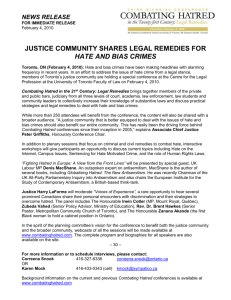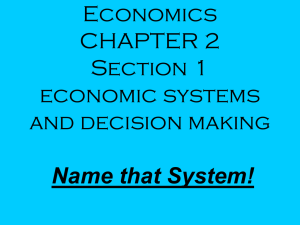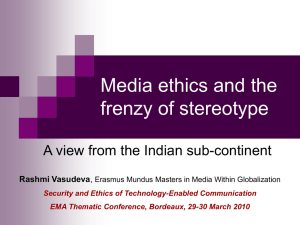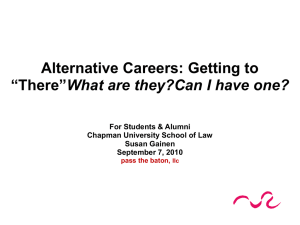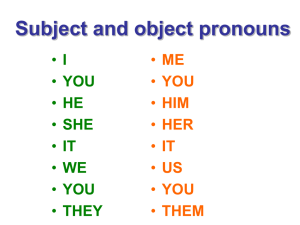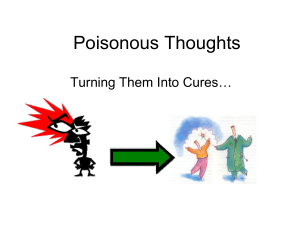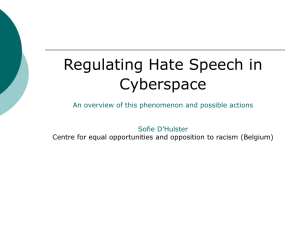HATE SPEECH
advertisement
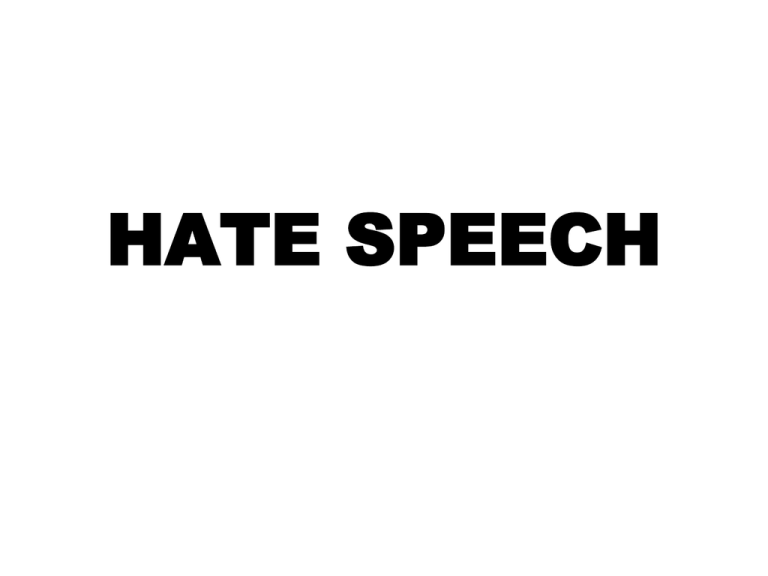
HATE SPEECH Content of the presentation • Definition of hate speech • Online manifestations • Impacts on young people • Practices online Definitions • Hate speech is defined as bias-motivated, hostile, malicious speech aimed at a person or a group of people because of some of their actual or perceived innate characteristics. It expresses discriminatory, intimidating, disapproving, antagonistic, and/or prejudicial attitudes towards those characteristics, which include gender, race, religion, ethnicity, color, national origin, disability or sexual orientation. Hate speech is intended to injure, dehumanize, harass, intimidate, debase, degrade and victimize the targeted groups, and to foment insensitivity and brutality against them • (Raphael Cohen-Amalgor, (2011) ‘Fighting Hate and Bigotry on the Internet, Policy and Internet, Vol. 3(3).) Definitions • The term hate speech shall be understood as covering all forms of expression which spread, incite, promote or justify racial hatred, xenophobia, anti-Semitism or other forms of hatred based on intolerance, including: intolerance expressed by aggressive nationalism and ethnocentrism, discrimination and hostility against minorities, migrants and people of immigrant origin. • (Committee of Ministers of the Council of Europe, Recommendation on hate speech, 1997). Dimensions of Hate Speech • • • • • • Content Tone Context Targets Potential implications Intention Relation to other phenomena • • • • • • • • • • Racism Semitism Xenophobia Discrimination Human Rights – freedom of expression Gender LGBTQI issues Religions Extremism Disabled people Fields of occurance • • • • • • • Everyday life – privacy Media (printed media, TV, Radio, Internet) Politics Govermental structures, institutions Schools - bullying Social ‘science’ Hate crime – Law and order Bias motivations recorded in hate crime figures (OSCE 2009) Online manifestations • • • • • • • • Websites Social media Blogs Emails Memes Games Chatrooms, forums Videos Impacts on young people Young people as targets of recruitment: • Internet is a learning space for easy ideas • Hate patterns reach out for youth involvement • Emotional risk Young people as victims: • Sensitive identity and personality • Emotiional or psychological harm • Social harm • Physical harm • Suicide (in extreme situations) Combating hate speech online • • • • • • • Monitoring and research Receiving and investigating complaints Working with ISPs and the law Education , training and awareness raising Public campaigns Victim support and community building International cooperation Online solutions • • • • • http://www.inhope.org http://standuptohate.blogspot.fr http://www.saferinternet.org http://www.inach.net/ http://www.enacso.eu/ Offline solutions for online Campaigns • Awareness Campaigns: campaigns that are aiming to raise awareness in wider public concerning discrimination and hate speech in general • Affirmative Campaigns: campaigns that are presenting minority groups in a positive way for a wider public in order to prevent discriminative behaviours • Obstructive Campaigns: campaigns that are collecting information about discriminative sites, actions online and also trying to take steps to restrict or obstruct the activity Affirmative campaigns www.allout.com http://www.youngjewishproud.org http://www.ergonetwork.org/ergonetwork/campaigns/typical-roma/ http://www.islamispeace.org.uk NoHateSpeech Movement Project (CoE) • The project aims at combating racism and discrimination in their online expression of hate speech by equipping young people and youth organizations with the competences necessary to recognize and act against such human rights violations. • The project stands for equality, dignity, human rights and diversity. • The project does not promote the limitation of freedom of expression in any form. • The whole project is a tribute to youth participation and co-management. Thank you for your attention!



